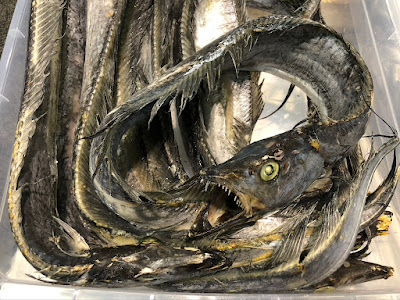Some people rant about aquaculture, believing it's harmful and that farmed seafood doesn't taste as good as wild caught. To a large degree, they are mistaken and aquaculture is clearly the future of the seafood industry. Historically, about sixty years ago, in 1961, 95% of total seafood production in the U.S. was wild capture while only 5% involved aquaculture. However, the amount of aquaculture has grown every year since then, and now it is the majority.
In 2013, the proportion of aquaculture exceeded wild capture for the first time, and currently total production is now 56% aquaculture and 44% wild capture. In 2019, wild capture declined 4.1% while aquaculture increased by 3.74%. It's believed that aquaculture in the coming years will grow by about 62%.
In 2013, the proportion of aquaculture exceeded wild capture for the first time, and currently total production is now 56% aquaculture and 44% wild capture. In 2019, wild capture declined 4.1% while aquaculture increased by 3.74%. It's believed that aquaculture in the coming years will grow by about 62%.
During the past sixty years, the practice of aquaculture has improved in leaps and bounds, helping to resolve some of the earliest problems that occurred with aquaculture. The growth in improvement of aquaculture is stunning, far outstripping any gains in the farming of beef, pork, chicken, etc. Many aquaculture products have now been certified as sustainable by various organizations. It's time for people to eliminate their prejudices against farmed seafood.
As for wild capture in 2020, total U.S. commercial landings were about 8.4 billion pounds, valued at $4.78 Billion, which was a decrease from the prior year of $818 Million. The top landed species, by volume, was Alaska Pollock, constituting about 3.2 Billion pounds, nearly 40% of the total. The rest of the Top 10 landings, by volume, included: Menhadens, Hake/Whiting, Pacific Cod, Yellowfin/Salmon, Sockeye Salmon, Pink Sole, Rockfish/Pacific Ocean Perch, Mackeral/Atka, and American Lobster.
Pollock has become the "white fish" of choice in many prepared and frozen fish products, from fried fish sandwiches to frozen fish sticks.
The top landed species, by value, was the American Lobster, constituting about $530 Million. The rest of the Top 10 landings, by value, included: Sea Scallop, Pollock/Walleye, Sockeye Salmon, Northern White Shrimp, Dungeness Crab, Menhadens, Blue Crab, Eastern Oyster, and Pacific Cod. It's probably no surprise that lobster is the most valued landing.
The U.S. also exported about 2.8 billion pounds of seafood in 2021, valued at about $5.5 billion, an increase of 355 million pounds (+14.7%) and $952 million (+22.6%) compared to 2020. The Top 10 cxports included: Pollock, Salmon, Hake, Squid, Soles, Lobster, Mackerel, Cod, Ocean Perch, and Crab. So, the U.S. exports nearly 35% of all their landings.
In addition, in 2021, the U.S. imported seafood totaling about 7 Billion pounds, valued at $28 Bllion; an increase from 2020 of about 747 Million pounds (+12%) and $6.5 Billion (+30%). The Top 10 imports included: Shrimp, Salmon, Tuna, Tilapia, Crab, Catfish, Cod, Squid, Lobster, and Pollock. I'll add that in 2021, Shrimp imports were also at their highest ever recorded level, almost 2 Billion pounds. Shrimp remains hugely popular and most of the shrimp consumed in the U.S. is imported from around the world.
Finally, the article noted numerous challenges currently facing the seafood industry, although many of these issues are faced by all industries during these trying times. Their issues include: shipping delays, labor shortages, increased cold storage fees, elevated replacement costs, container shortages, rising freight costs, tempered production, and active demand. This has all contributed to an increase in seafood prices, and as many consumers already thought seafood was too expensive, this hasn't helped increase the consumption of seafood.
Finally, the article noted numerous challenges currently facing the seafood industry, although many of these issues are faced by all industries during these trying times. Their issues include: shipping delays, labor shortages, increased cold storage fees, elevated replacement costs, container shortages, rising freight costs, tempered production, and active demand. This has all contributed to an increase in seafood prices, and as many consumers already thought seafood was too expensive, this hasn't helped increase the consumption of seafood.






No comments:
Post a Comment